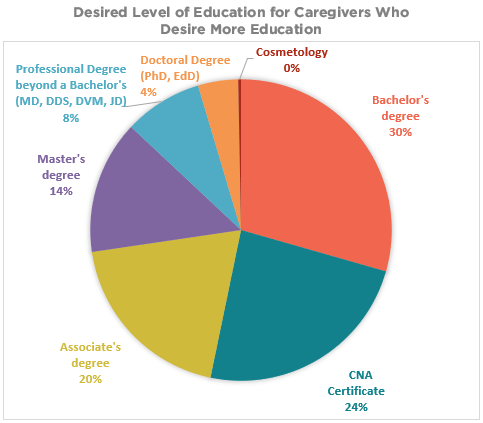Home care providers are already under pressure to offer educational opportunities to their workers, as a means of boosting recruitment and retention in an industry plagued by labor shortages and high turnover. Changes in the insurance landscape and shifting workforce demographics could ratchet up that pressure to new levels of intensity in the coming years.
Recently, the Centers for Medicare & Medicaid Services (CMS) proposed making non-skilled home-based services a benefit in Medicare Advantage (MA) plans. The details are scarce and the proposal still has a long way to go before being finalized, but providers are already weighing possible opportunities and implications. Sherwin Sheik, CEO of CareLinx, believes there is a good chance that MA plans will indeed begin covering private duty home care services starting in 2019, and that this will mean providers need to up their game when it comes to educating caregivers such as certified nursing assistants (CNAs).
“You’re going to see a huge explosion in the demand for home care, because health insurance companies will realize that tasks historically done by skilled home health can now be done by CNA-level staff,” Sheik told Home Health Care News. “We need to have more labor come into the industry to meet this growing demand … and continuing education to make sure the workforce can meet [patient and payor] needs.”
Sheik’s assessment is based on what CareLinx is experiencing in working with hospital and health systems, and other types managed care organizations.
CareLinx is an online platform with more than 250,000 caregivers serving markets around the country. Individuals in need of home care can find a caregiver and manage hiring and payment through the digital platform, but the company is also increasingly working with large provider and payor groups. These are turning to CareLinx to provide home care services for their patient and populations. For instance, one system with 92 hospitals in 22 states has arranged to make CareLinx “an extension of the health system,” Sheik said.
These health care organizations have high expectations for their partners across the continuum of care, as they are seeking to improve patient outcomes while keeping costs down—for example, by reducing hospitalizations and readmissions. This means that in some cases, there are education-related requirements that CareLinx caregivers must meet in order to take clients from the company’s managed care partners.
CareLinx offers more than 25 courses to caregivers on its platform. The courses are provided by CareAcademy, which specializes in educational content and resources for home care workers. As CareLinx caregivers take and pass various classes, they earn “badges” that appear on their CareLinx profile, such as silver, gold, platinum and diamond. The courses are available at no charge to the caregivers. CareLinx is able to cover the costs due to its scale and the way it has structured contracts with the large health care players who demand high-quality home care workers, Sheik said.
The caregivers have an incentive to take these classes; CareLinx workers who are providing care within the health system structures are earning 60% to 70% higher wages than at a traditional agency, according to Sheik.
Younger caregivers crave education
At the same time that Medicare Advantage changes might increase the need for home care workforce education, another trend is also fueling demand for more robust professional development in the industry. That trend is the influx of younger caregivers.
Members of the millennial generation, born between 1982 and 2000, are on their way to being the largest contingent of the U.S. workforce, and their significant interest in nursing has taken researchers by surprise.
Younger home care workers are more avid for further education than their older colleagues, according to recently released survey findings from CareAcademy and Southern New Hampshire University. The survey of 765 caregivers found that those 45 years or younger were 18% more willing to attain further education than those 45 or older. That held across all ethnicities and genders. Just a one-year increase in age reduced the odds of a caregiver considering further education by 4%.
This finding suggests that home care companies with educational offerings will have more success attracting and retaining younger workers. But there is hunger for more education across the board in home care. Asked if they were considering more education, 52% of all respondents said yes.
The figure was higher for black or African-American caregivers (55%) and Latino/Latina/Hispanic caregivers (57%), though it was lower (42%) for white caregivers. And unsurprisingly, lower-earning workers appear to be eager for education that might increase their wages, with 54% of those bringing in less than $35,000 a year saying they are interested.

The desire for further education might in fact be even greater than the survey captured, CareAcademy co-founder and CEO Helen Adeosun told HHCN.
“Could we have asked a set of questions to determine if people were saying no, [I’m not interested in more education], because they had already said to themselves, I can’t afford it or don’t have time?” she said.
Affordability of training programs came in as the No. 1 impediment to further education, cited by 60% of respondents. This did not surprise Adeosun. A CNA credentialing program might realistically set a caregiver back anywhere between $200 and $1,500, she said.
Covering these costs, like CareLinx does, might therefore be a best practice. Adeosun acknowledges that not every provider has the means to do so, but there are still steps that can be taken.
“There are agencies out there with cost considerations in mind that go into the community and say, what resources can I leverage in order to make this benefit happen?” she said. “It’s leveraging the local community college … based on the income levels of these caregivers, a lot are Pell Grant eligible. Within workforce development overall, there are millions of dollars [available for] training and education.”
CareAcademy is looking to provide more services to help providers handle the logistics of marshaling these resources, but Adeosun stressed that even smaller or new agencies should prioritize modest investments in continuing education, pointing to the pressing need for better retention and the increasing demands placed on home care by the health system at large.
“Education is increasingly a must-have,” she said.
Written by Tim Mullaney




